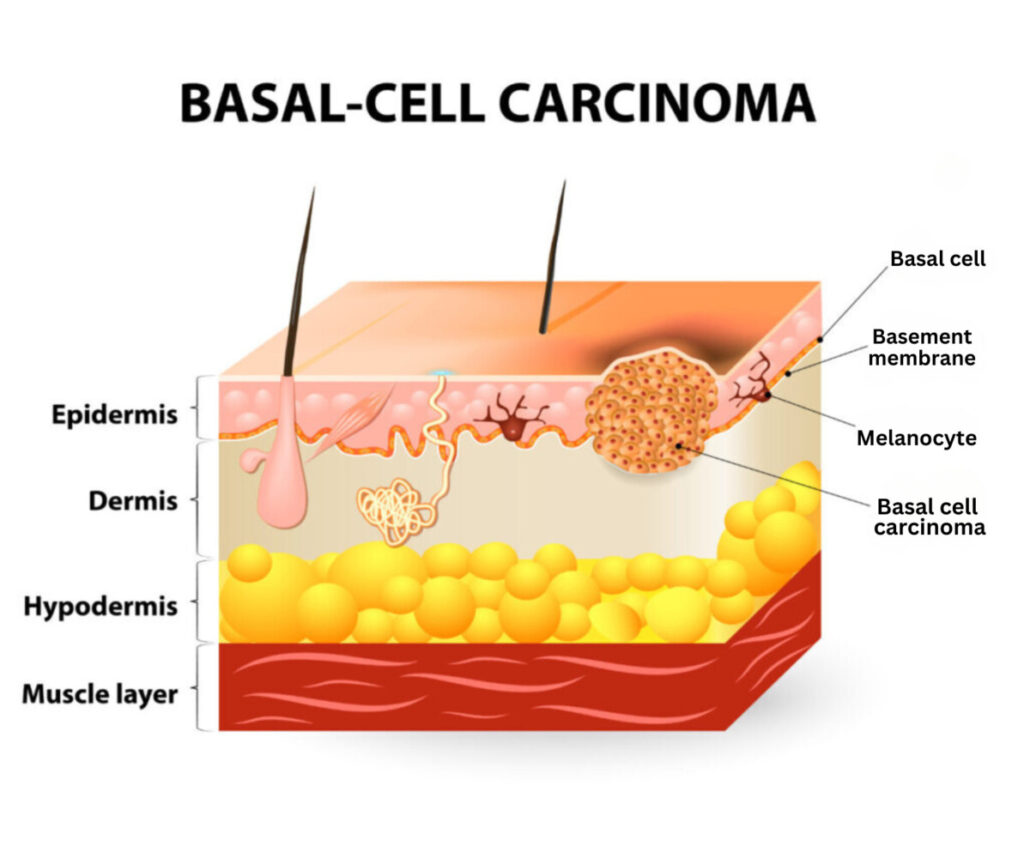
Basal cell carcinoma (BCC) is the most common skin cancer. Read below to learn more about this cancer.
Some Facts
Basal cell carcinoma is the most common skin cancer in the United Kingdom and the most frequently occurring cancer overall According to the British Association of Dermatologists, there were 158,934 basal cell carcinomas in the United Kingdom in 2019, up from 34,672 in 2013. Basal cell carcinoma is a growing problem:
Why are the numbers increasing?
- We are doing more skin cancer screening, which means we find more types of skin cancers, particularly BCCs, since they are so common
- The population is aging—we know that basal cell carcinomas are caused by cumulative sun damage to the skin
- Our ultraviolet (UV) radiation exposure is increasing because of the depletion of the ozone layer
Details About This Cancer
BCC is one of three more common types of skin cancer described here. As shown in the diagram, the top layer of your skin, the epidermis, is made up of basal cells, melanocytes, and squamous cells. The basal cells form the bottom portion of this layer, and these cells eventually move up, change, and become the squamous cells that flake off. When basal cells become cancerous, the condition is known as basal cell carcinoma (BCC). Melanocytes are the cells that produce a brown pigment called melanin to add colour to our skin. If these cells become cancerous, the condition is called melanoma. Squamous cells, which are found in the upper portions of the epidermis, make a protein called keratin, which is found in our skin, hair, and nails. When they grow out of control and become cancerous, they develop into squamous cell skin cancer. What is basal cell carcinoma like? For pictures of basal cell carcinoma, see IMAGES. Here are some details about this cancer:
- BCC is usually associated with excess UV light exposure, so it mostly occurs in sun-exposed areas of the skin. BCC looks differently in different people and in different locations
- BCC commonly occurs as:
- An open sore that bleeds, oozes, or crusts and remains open for several weeks
- A reddish, raised patch or irritated area that may crust or itch but generally doesn’t hurt
- A shiny pink, red, pearly white, or translucent bump
- A pink growth with a raised border and crusted central indentation
- A scar-like, white, yellow, or waxy area, often with a poorly defined edge
- A darker, pearly translucent skin growth in people of colour or as the more translucent variety typically seen in white-skinned individuals. For people of colour, it often appears on the head or neck
- BCC is a slow growing tumour. While highly treatable, it can grow slowly and invade underlying nerves, blood vessels, and bone, leading to symptoms and disfigurement. Treatment at an earlier stage will almost always be less complicated and leave less scarring.

